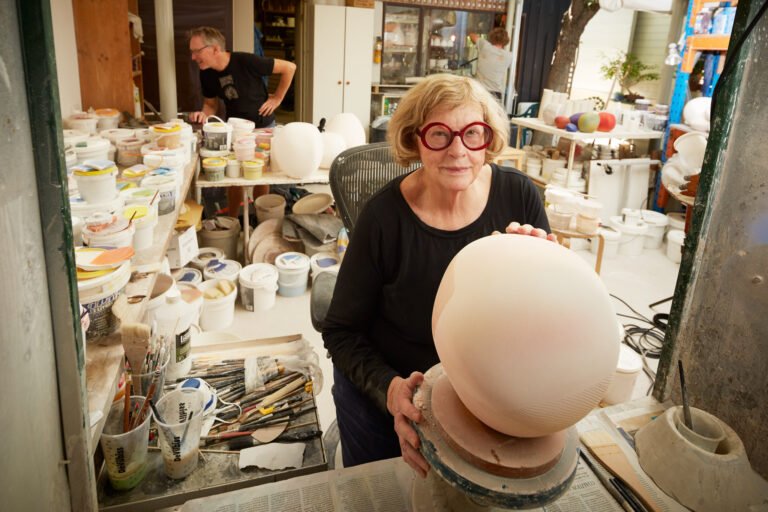When artist Ian de Souza and his wife Ros decided to open their home for their first artists’ open house event and walking tour in their creative-enclave neighbourhood, they weren’t entirely sure who would show up on their doorstep.
‘In our first year [in 2014], we opened four artists’ homes in our area, and it was a real experiment,’ Ros de Souza explains. ‘We had a budget of about $400 and we put some posters up in the street to advertise it and did some posts on social media, when back then, social media was something fresh,’ she adds.
Looking back, that shoestring experiment, which was trialled at a time when art sales were at a low ebb in the wake of the world financial crisis, marked the start of a program that has grown into a successful biannual known as Artwalk Freo – centered around Fremantle in Western Australia.
And aside from generating strong sales for the artists – art worth between $50,000 and $70,000 has been sold each time – Artwalk Freo has also taught the de Souzas that their grassroots initiative has a number of other vital flow-on effects for the art market overall.
Art trails nurturing new generations of art-buyers
As Ros de Souza explains, many of their Artwalk attendees are not the people the artists would normally see at their opening night in-gallery events. Indeed, some have never set foot in a conventional gallery space before in their lives.
‘These events are not just about having artwork for sale,’ she tells ArtsHub.
‘It also breaks the ice for many people, because, let’s face it, galleries can be quite scary places for people who aren’t familiar with them.’
She adds that, remarkably, many people feel more comfortable stepping inside an artist’s home than they do wandering into their local galleries to look at that artist’s work in a “white cubed” space.
‘First of all, I think there is a little voyeurism in all of us to see how other people live,’ she says.
‘But ultimately, people are coming because they want to connect with artists and talk with them about their work.
‘And once they connect personally with the artist, they often start following them with more interest, and are more likely to attend their next gallery exhibitions.’
Read: Tips on maximising your open studio event
On the other side of the country, independent producer Erin Adams, who has been running her Pop-Up Project art trail since 2021, in the Southern Highlands in regional country an hour from Sydney. She agrees wholeheartedly.
‘When people who are not ordinarily immersed in the art world get to see inside artists’ studios and talk with them, it allows them to appreciate the amount of work involved in making art, and they leave with a much deeper appreciation for why art costs what it does,’ she says.
‘And while you never really know when people are going to buy a piece of art, once people know about our arts trail and meet the artists, it definitely sets them on a pathway where buying art is no longer an abstract or remote concept for them. It becomes a real possibility – if not now, then sometime in their future.’
Adams’ first Pop-Up Project event was held in 2021 and attracted 1000 people with $20,000 in total sales. In 2022, 15 artists opened their homes and studios, and made $32,000 in sales, and then, last year, the event expanded to 40 artists, which attracted 2500 people over the June long weekend, and $57,000 worth of art was sold.
Artists’ talk encouraging more people to sign up
So, could it be that we are seeing these non-threatening and informative open studio events acting as growing gateways (or perhaps “welcome mats”) to the gallery-going and art-collecting scene at large?
As dynamic and fun arts experiences, they appear to be breaking down barriers for people who may have previously walked straight past conventional gallery spaces due to their fear that they may not understand what they’ll see inside.
But after meeting the artists in their studios, these same people are willing to sign up to those galleries’ mailing lists to make sure they don’t miss the news of when the artists’ next in-gallery exhibitions will be.
From that point of view, it’s win-win.
Read: Famous artists’ homes that are now museums
But, as Ros de Souza explains, the experience of being part of an open house event is not something artists should walk into lightly.
‘It’s actually a very exhausting day for the artists,’ she says. ‘It’s full-on talking from 10am until 4pm, so I make sure I tell the artists they must take breaks at some points during the day to recharge for few minutes, because it’s so draining to be talking so much to so many people all day long.’
Over in the Southern Highlands, Erin Adams agrees that the artists involved must be prepared for long days of extended chats with their visitors.
‘I would say most of the artists in our group are great talkers,’ she says.
‘A few are actually very introverted, and the main reason they join the trail is to meet other artists!’ she laughs. ‘But that’s also a great outcome, because it’s bringing the artist community closer together.’
Ros de Souza makes a similar observation. ‘It really brings the visual arts community alive, because artists often take the opportunity to visit other artists to speak with them and see what works they are collecting, and what kind of art they surround themselves with,’ she says.
‘Ultimately, there’s a great intimacy involved,’ she adds.
‘But that’s what art is, isn’t it? Art is a very intimate thing, and that’s why we are drawn so powerfully to it.’

